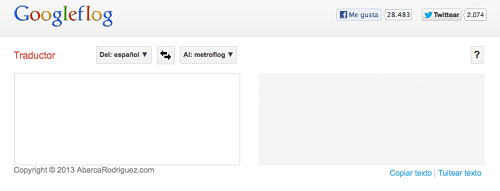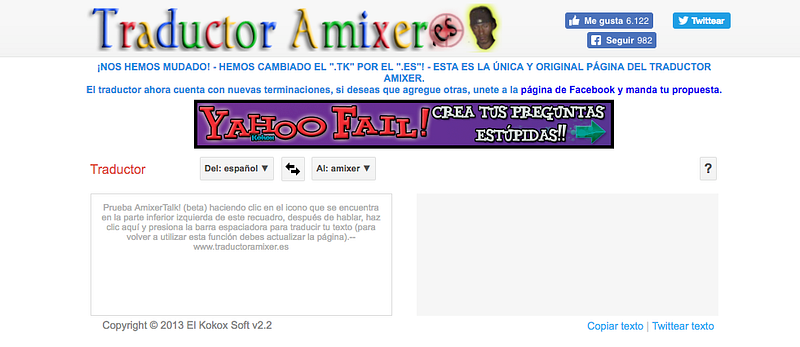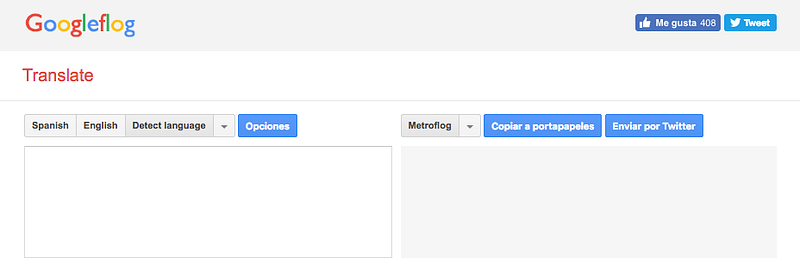Back in 2013, I built a parody of Google Translator called Googleflog. The application was pretty simple; it “translated” human sentences or words into “meEzhzheEd up TeExT”.
 Googleflog in 2003.
Googleflog in 2003.
I coded it in one slow office Friday afternoon using a simple dictionary and weaked it a little bit later that night.
The idea behind the translator emerged from a trend in Latin America focusing on he way young people wrote comments on a social network called Metroflog — hence he name Googleflog — and how they loved to obfuscate, repeat and randomly switch letter case with their keyboards.
I shared it with my friends and shared it with a tweet, but it didn’t receive ny attention at all. I didn’t pay attention to the stats or shares because I idn’t expect that that was a joke worth making.
 I was wrong.
I was wrong.
One day, I noticed something weird while checking the Analytics stats; it was displaying more than 1,200 active visitors and the current count for that day was 25,000. This was the first time I experienced a viralization in something that I had done on my own. It was beautiful to see those stats rise so fast, leaving the previous stats like little rocks in front of the mountain of the current streak.
I acted fast and called my hosting provider — I was using a shared hosting that actually already handled the peak; I added ads from Adsense at the bottom and started making searches on Twitter, Facebook, and Google to monitor the sharing.
At the end of the first day, the stats closed with more than 50,000 unique visitors and this kept going for 10 days. I changed the ads a couple of times during those days to boost the revenue.
At the end of the 10 day streak, it started to slow down. It was shared more than 150,000 times on Facebook and 10,000 on Twitter. It was posted in several forums, big and small Facebook pages, and even in serious news sites and fake news sites. I even bought a TV and a bicycle with the paycheck Adsense sent me for the month. I thought that was it! Good game! But no.
I was wrong again.
Oh no, boy. Googleflog went viral only in Mexico. One month later, I had 10–15 day peaks of less than 50,000 unique visitors coming from Argentina. Two months later, it viralized in Spain with similar stats. Then finally in Peru and Colombia at the same time for a couple of days.
During those two later streaks, I tweaked the language several times to cover all of Latin America and Spain slangs, so that people would find it easier in the search engines — thank you Analytics. I also added a simple API to be used by other people; someone even built an android application ⧉.
I got job offers in Mexico because of this little application. Even 1 year later, I was called from a startup in Argentina that knew I was moving there and wanted me on their team; they mentioned Googleflog several times.
So, eventually, clones began to appear, having more traffic than I did. I did not take this personal, since you know what they say: “Copying is the best form of flattery”.
 Ugly clone from Peru.
Ugly clone from Peru.
There is a dedicated site ⧉ for the Peru folks that ripped off the entire Googleflog application, and at that time I coded a Yahoo Question generator ⧉, and they ripped that off too ⧉.
I remember one site that ripped off the whole application too, but left one of the main script sources pointing to my site. I had fun with them for a while, since it was the easiest deface ⧉ I ever did and I managed to affect the whole site, which shut down months later.
Nowadays, I enjoy seeing mentions on Twitter by people who share the site using the share button and I search from time to time to see if people still visit it. It was a very fun exercise and, because of this, and many other reasons, I try to encourage people to build stuff.
The web page lost all the likes on Facebook because I changed the domain and they updated that in 2014; it had more than 400,000 shares. Twitter shares are gone too, since Twitter removed the count from their share buttons, but had more than 3,500 shares.
 Googleflog today.
Googleflog today.
A couple of months ago, I refactored the application (source ⧉ and live), built a Javascript package (source ⧉) to be used in Node.js, AMD, CommonJS and the browser, also published as an npm package ⧉, and finally a Hubot script ⧉ to use in your Slack’s bot.
In the news
- http://es.ccm.net/faq/24299-como-escribir-en-turro-con-un-traductor-turro ⧉
- http://elaltavoz.mx/2013/11/14/hacen-falta-palabras-columna/ ⧉
- http://www.v-junker.com/googleflog-traductor-de-espanol-a-idioma-metroflog/ ⧉
- http://diaadia.viapais.com.ar/tu-dia/tus-hijos/googleflog-para-escribir-como-adolescentes ⧉
That’s it for now, until next time!